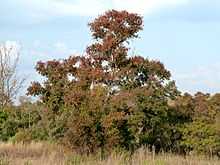Combretum erythrophyllum
| Combretum erythrophyllum | |
|---|---|
 | |
| In autumn colours at Tierpoort, Gauteng | |
| Scientific classification | |
| Kingdom: | Plantae |
| (unranked): | Angiosperms |
| (unranked): | Eudicots |
| (unranked): | Rosids |
| Order: | Myrtales |
| Family: | Combretaceae |
| Genus: | Combretum |
| Species: | C. erythrophyllum |
| Binomial name | |
| Combretum erythrophyllum (Burch.) Sond. | |
Combretum erythrophyllum is a large tree found in the bush along the river banks in southern Africa.
Common names
Riviervaderlandswilg (Afrikaans); uMdubu (Zulu);[1] Modubunoka / Modubu (Pedi);[2] River combretum, River Bushwillow. C. glomeruliflorum
Description
A medium to large tree 7 to 12 m in height. Straight or multi-stemmed with dense spreading crown. The bark is a smooth pale gray or yellow brown that flakes with age to expose pale bark patches with large lumps (not galls) sometimes occur on older trunks and main branches.
Leaves: Simple leaves, opposite, elliptic with tapering base and apex (50 x 20 mm)upper surface usually without hairs undersurface has hairs .[3] The rib and lateral veins of the leaf are very conspicuous. Deciduous, leaves turn yellow and red in autumn (the specific name erythrophyllum means red leaf)
Flowers: Greenish-yellow in dense auxiliary spikes about 10 mm in diameter appearing after the first leaves (spring-early summer).
Fruit: 4-winged fruit yellow to brown in colour 10 to 15 mm in length.
Distribution
Found in riverine bush or where there is sufficient ground water in Botswana; Mozambique; South Africa; Swaziland; Zambia; Zimbabwe.[4]
Ecology
Wasps lay their eggs in the walls of the fruit and the larvae feed on the seeds inside the fruit. The Southern Black Tit taps the fruit to check if there are larvae inside, when discovered they open the fruit and eat the larvae.
Combretum erythrophyllum leaves are browsed by giraffe, elephant, bushbuck and nyala. [4]
Frost and drought hardy.
Medicinal uses
- The roots (regarded as poisonous) are used as a purgative and to treat venereal diseases.
- The bark is mixed with other herbs to make a decoction that is drunk in the morning and evening, quarter of a cup for sores.
- The fruit are regarded as poisonous and reputedly cause hiccups.
References
- ↑ Mthethwa, Ntombeziningi Shirley (2009). "Antimicrobial activity testing of traditionally used plants for treating wounds and sores at Ongoye area KwaZulu-Natal, South Africa.". Retrieved October 16, 2011.
- ↑ "erythrophyllum". Retrieved October 16, 2011.
- ↑ Coates-Palgraves, Keith (1990). Trees of Southern Africa. Struik. p. 667. ISBN 978-0-86977-081-8.
- ↑ 4.0 4.1 "Combretum erythrophyllum". operationwildflower.org.za. Retrieved October 16, 2011.